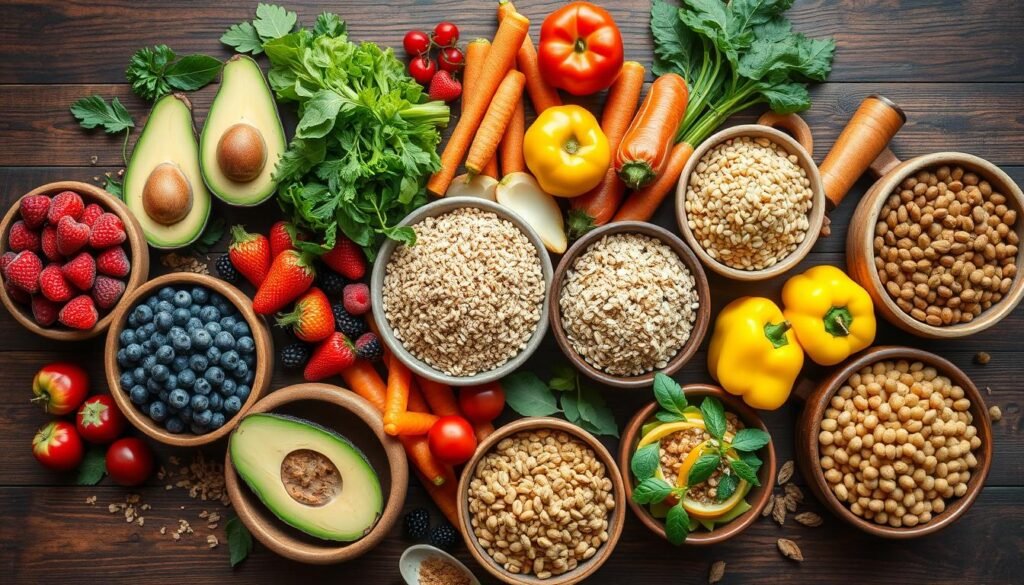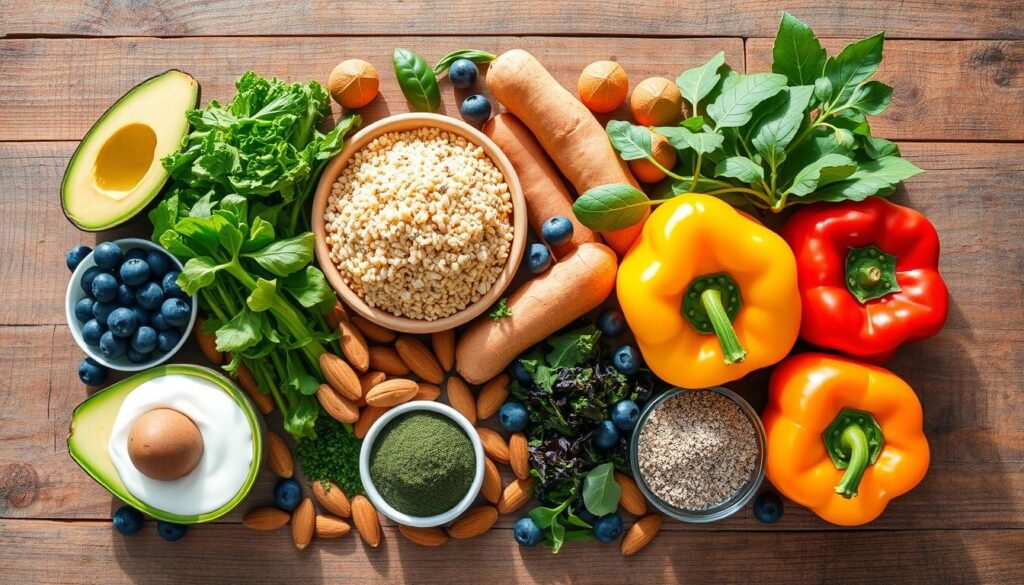Starting your weight loss journey can be tough. Finding foods that are both filling and nutritious is key. This balance is not always easy, but it’s doable with the right foods.
In this article, we’ll look at 10 foods that help you lose weight and give you energy. These foods are full of nutrients and will help you feel great. They include fiber-rich legumes and superfoods that boost your metabolism.
Key Takeaways
- Discover energy-boosting foods that promote weight loss and keep you satisfied.
- Learn about the connection between energy levels and weight management.
- Explore nutrient-rich options like beans, oats, sweet potatoes, and chia seeds that provide sustained energy and support metabolism.
- Understand how protein-rich foods like Greek yogurt and lean meats contribute to fullness and weight loss.
- Incorporate these 10 weight-loss friendly foods into your diet for a more energized and fulfilling weight loss journey.
Understanding the Connection Between Energy and Weight Loss
Weight loss isn’t just about cutting calories. It’s about how your energy, metabolism, and food choices work together. Eating the right foods boosts your energy, improves gym performance, and sharpens your mind. These factors are key to managing your weight well.
How Energy Levels Impact Weight Management
Low energy makes it hard to stay active and avoid eating too much. But, feeling full of energy helps you make better food choices and stick to your workout plan. The Institute of Medicine suggests 60 minutes of activity daily for weight control, showing how important energy is.
The Role of Nutrient-Dense Foods in Energy Production
Eating nutrient-dense, whole foods keeps your energy up all day. These foods give your body the vitamins, minerals, and nutrients it needs. By choosing clean and mindful eating, you help your body get the right fuel for weight loss.
Metabolism and Energy Balance
Your metabolism is key to balancing energy and managing weight. When it works well, your body burns calories and turns nutrients into energy. High-protein diets can boost metabolism and help keep muscle mass while losing weight.
| Nutrient-Dense Food | Calorie Count |
|---|---|
| Raisins (1 cup) | 480 calories |
| Grapes (1 cup) | 104 calories |
| Grapefruit (half) | 64 calories |
| Carrots (medium) | 25 calories |
| Popcorn (1 cup, air-popped) | 30 calories |
Knowing how energy, metabolism, and weight loss are connected helps you make better choices. These choices support your health and help you reach your goals.
Protein-Rich Foods for Sustainable Weight Loss
Protein is key for weight loss. It makes you feel full and supports muscle health. Adding protein-rich foods to your diet helps manage weight and keeps energy levels up.
High-protein foods like eggs and Greek yogurt can make you feel full for hours. This can lead to eating less at later meals. Foods like boiled potatoes and chia seeds also help you feel full and eat less.
Protein is important for muscle health. Foods like lean meats and fish help build and keep muscle, even when you’re eating fewer calories.
| High-Protein Food | Protein Content (per serving) |
|---|---|
| Salmon (178g fillet) | 39.3g |
| Chicken Breast (100g) | 22.5g |
| Ground Beef (85g) | 21.3g |
| Tuna (107g can) | 20.3g |
| Bison Meat (85g) | 21.6g |
| Pork (113g) | 19.1g |
| Turkey Breast (85g) | 25.6g |
| Halibut (159g) | 29.3g |
| Egg (1 large) | 6.3g |
| Greek Yogurt (200g) | 19.9g |
| Cottage Cheese (113g) | 12.5g |
| Cow’s Milk (244g) | 8g |
To lose weight with protein, eat a variety of protein-rich foods. Include lean meats, fish, eggs, dairy, and plant-based options like spirulina. This way, you support your weight loss goals and stay full and energized.
Food For Weight Loss, Weight-loss foods, healthy, eating for weight loss
For weight loss, focus on foods that are full of nutrients but low in calories. These foods keep you full and give you energy. Learning about caloric density and using portion control can help you lose weight in a healthy way.
Understanding Caloric Density
Caloric density is how many calories a food has per gram. Foods like fruits, veggies, and lean proteins are filling and have fewer calories. Choosing these foods helps you feel full without eating too many calories, making it easier to stay healthy.
Portion Control Strategies
- Use smaller plates and bowls to help control portion sizes.
- Slow down your eating and savor each bite to allow your body to recognize when you’re full.
- Incorporate high-fiber foods like vegetables, fruits, and whole grains to promote feelings of fullness and satisfaction.
- Prioritize protein-rich foods, as they have been shown to support appetite regulation and weight management.
Meal Timing for Optimal Results
When you eat can also affect weight loss. Intermittent fasting, where you only eat during certain times, might help with weight management. It can improve how your body handles insulin and reduce inflammation.
A balanced diet and regular exercise are key for losing weight. Eating nutrient-dense foods, controlling portions, and timing your meals right can lead to lasting success.
| Diet | Key Characteristics | Benefits for Weight Loss |
|---|---|---|
| Mediterranean Diet | Emphasizes plant-based foods, healthy fats, and limited processed items | Promotes weight loss and overall health |
| DASH Diet | Focuses on fruits, vegetables, and low-fat dairy, with reduced sodium intake | Supports heart health and can aid in weight management |
| MIND Diet | Blends elements of the Mediterranean and DASH diets, targeting brain health | May contribute to weight loss and reduced cognitive decline |
| Nordic Diet | Emphasizes whole, seasonal, and locally-sourced foods from Scandinavian countries | Linked to weight loss, improved heart health, and stroke prevention |
Understanding caloric density, portion control, and meal timing helps you create a healthy diet. A balanced diet with intermittent fasting and healthy eating habits can lead to lasting results.
High-Fiber Foods That Support Weight Management
Fiber is key for lasting weight loss. It helps with digestion and keeps you full. Adding high-fiber foods to your diet can help control hunger and aid in weight loss.
Fiber is a carb that your body can’t digest fully. It has two types: soluble and insoluble. Soluble fiber, found in oats, beans, and berries, slows down nutrient absorption. This leads to a steady blood sugar rise and keeps you full. Insoluble fiber, in whole grains and veggies, makes your stool bulkier and helps food move through your system.
Adding high-fiber foods to your diet can greatly help with weight management. For example, a cup of kidney beans gives you a third of your daily fiber. A pear has 5.5 grams of fiber per 100 grams. Other good sources include:
- Lentils (10.7 grams of fiber per 100 grams)
- Avocado (6.7 grams of fiber per 100 grams)
- Broccoli (2.4 grams of fiber per 100 grams)
- Quinoa (2.8 grams of fiber per 100 grams)
- Popcorn (14.5 grams of fiber per 100 grams)
Mixing these high-fiber foods with lean protein can help you feel full longer. A diet full of low-carb, high-fiber foods supports healthy eating and satiety. It’s a great tool for managing your weight.

“Fiber can help promote weight loss, lower blood sugar, fight constipation, boost heart health, and feed friendly gut bacteria.”
The Power of Healthy Fats in Weight Loss
Healthy fats are often overlooked in weight loss. But, adding the right fats to your diet can boost energy and help manage weight. Learn how essential fatty acids and omega-3 foods support your diet goals.
Essential Fatty Acids and Satiety
Healthy fats like monounsaturated and polyunsaturated fats make you feel full. Essential fatty acids like omega-3s help control hunger hormones. This can lead to eating less and losing weight more easily.
Incorporating Good Fats into Your Diet
Adding good fats to your diet is simple. Avocados, nuts, seeds, and fatty fish like salmon are great sources. These foods give you energy and support your health.
Benefits of Omega-3 Rich Foods
Omega-3s in foods like fatty fish, walnuts, and flaxseeds are good for weight control. They reduce inflammation, help control blood sugar, and boost metabolism. Try to eat at least two servings of omega-3 foods each week.
Healthy fats can change your weight loss journey. By eating fat-burning superfoods, you get lasting energy and balanced blood sugar. This supports a healthy, low-carb diet.
Nutrient-Dense Superfoods for Energy
To reach your weight loss goals, focus on eating nutrient-dense superfoods. These foods are not only filling but also boost your energy. The right foods can improve your metabolism, physical performance, and overall health.
Begin your day with a nutritious breakfast. Include kale, a low-calorie leafy green, for its fiber, vitamins, and minerals. Add blueberries for their antioxidants and vitamins. Broccoli is also a great choice, packed with fiber and vitamins.
Add chia seeds to your meals for their omega-3s, calcium, and protein. These can help with weight loss. Eggs are full of vitamins and protein, helping you feel full and manage your weight.
Make sure to eat avocado for its fiber and vitamins. Sweet potatoes are also good, with antioxidants and vitamins that aid in weight loss.
By eating these superfoods, you’ll increase your energy and give your body what it needs. These foods support your metabolism boosters, clean eating, and healthy eating habits. Add them to your diet for a successful weight loss journey.

“Eating nutrient-dense foods that satisfy the appetite is key for long-term weight management success.”
Low-Calorie Foods That Keep You Satisfied
Weight loss isn’t just about cutting calories. It’s about choosing the right foods that keep you full and energized. By adding nutrient-dense, low-calorie foods to your meals, you support your weight loss goals. You also enjoy meals that are satisfying and nourishing.
Volume Eating Strategies
Volume eating is a smart way to lose weight. It involves eating foods that are high in volume but low in calories. This way, you feel full without eating too many calories. Here are some great options:
- Oatmeal: A 1/2-cup serving of dry oats has 154 calories, 5 grams of protein, and 4 grams of fiber, helping to keep you satisfied.
- Nonfat Greek yogurt: A 1-cup serving has approximately 150 calories and 25 grams of protein, making it a filling and nutritious choice.
- Soup: A 1/2-cup serving of condensed chicken noodle soup contains about 60 calories and 3 grams of protein, and has been shown to decrease total calorie intake at meals.
Hydrating Foods for Weight Loss
Staying hydrated is key for weight management. Some foods can help you stay hydrated while providing extra nutrients. Here are some hydrating, low-calorie options:
- Blueberries: 1 cup of blueberries has 86 calories and 3.6 grams of fiber, helping to curb hunger and support weight loss.
- Eggs: A large egg has 72 calories, 6 grams of protein, and various vitamins and minerals, making it a satisfying and nutrient-dense choice.
- Popcorn: 1 cup of air-popped popcorn contains just 31 calories and 1.2 grams of dietary fiber, providing a crunchy, low-calorie snack option.
Smart Snacking Options
Choosing the right snacks is important for weight loss. Look for snacks that are low in calories but high in nutrients. Here are some smart snacking choices:
| Food | Calories | Nutrients |
|---|---|---|
| Chia seeds | 138 calories per 1 oz | 4.7 grams of protein, 9.8 grams of fiber |
| Cod | Under 60 calories per 3 oz | 13 grams of protein |
| Cottage cheese | 163 calories per 1 cup | 28 grams of protein |
By adding these foods to your meal planning, you can create a weight loss plan that’s sustainable and satisfying. You’ll stay energized and satisfied all day long.
The Role of Fermented Foods in Weight Management
Looking to help with weight loss? Try adding more fermented foods to your meals. Foods like yogurt, kefir, kimchi, and sauerkraut are full of benefits. They support healthy eating, boost metabolism, and improve gut health.
Fermented foods are packed with good bacteria, or probiotics. These help keep your gut healthy. A healthy gut is key for a good metabolism and managing weight. Eating fermented foods regularly can help you lose weight by reducing fat absorption and increasing fat loss.
These foods are also high in fiber. This can make you feel full and satisfied, helping you eat less. Research shows that eating more fiber can lead to weight loss, similar to strict diets.
- Yogurt and kefir are dairy-based fermented foods that contain live, active cultures to support gut health.
- Kimchi and sauerkraut are fermented vegetables that provide a flavorful way to boost your intake of beneficial bacteria.
- Fermented foods like these can help maintain a healthy balance of gut microbes, which is essential for regulating appetite, metabolism, and weight.
When adding fermented foods to your diet, watch your portion sizes. Choose options with less sugar and salt. Homemade fermented foods are usually the best choice because they keep more of their beneficial cultures.
“Fermented foods are one of the least consumed food types in the U.S., yet they can play a significant role in supporting healthy eating habits, boosting metabolism, and promoting gut health for weight management.”
By regularly eating fermented foods, you can use probiotics to help with weight loss. Adding these foods to your meals is a simple way to improve your gut health and overall well-being.
Strategic Meal Planning for Weight Loss Success
Meal planning is key for losing weight. It helps you eat a diet full of nutrients. This keeps you full and gives you energy all day. We’ll look at how to plan meals for weight loss, from making balanced meals to making prep easier.
Balanced Meal Components
A good meal plan has protein, fiber, and healthy fats. These nutrients help control hunger, keep blood sugar steady, and give energy. Try to have a lean protein, fiber-rich foods, and a bit of healthy fat in every meal.
Prep and Planning Tips
- Batch cook meals on weekends for quick, healthy options all week.
- Use meal planning apps or templates to fit your tastes and needs.
- Make a detailed grocery list by department to shop faster.
- Choose quick recipes, like those that cook in 15-20 minutes, to save time.
- Reheat meals safely to keep them fresh and avoid waste.
Sample Meal Ideas
There are many healthy meal options for weight loss. Look for simple recipes with lean proteins, fiber, and healthy fats. Try grilled salmon with veggies, a vegetable soup, or whole-grain pasta with lean turkey and tomato sauce.
For lasting weight loss, eat a balanced, nutrient-rich diet. By planning your meals well, you can achieve your health goals and feel great.
Conclusion
Incorporating nutrient-dense foods into your diet can change the game for weight loss. These foods keep you full and satisfied. They also provide the nutrients your body needs to thrive.
Understanding how energy and weight management are connected helps you make better choices. Successful weight loss isn’t just about dieting. It’s about nourishing your body and fueling your lifestyle. Try out the meal planning strategies and recipes we shared to find what works for you.
Whether you want to lose weight, boost energy, or improve your food relationship, these strategies can help. Embrace nutrient-dense, filling foods. Enjoy the journey to a healthier, more energized you.




